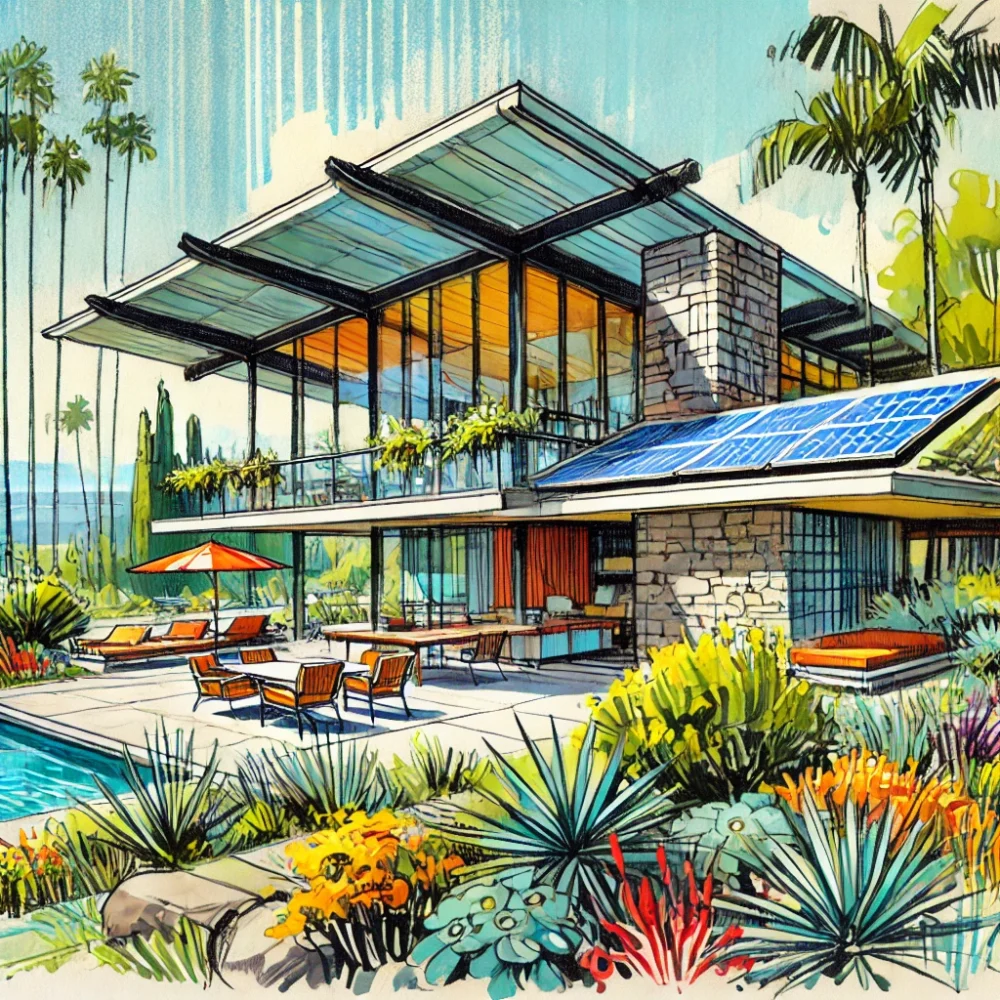How Hawaii Modern Architecture Shaped Ossipoff’s Designs
Imagine standing on a ridge high above Nānākuli Valley, where the clouds drift lazily through the Waiʻanae Mountains and the Pacific shimmers in the distance. You’re not just taking in a view; you’re experiencing a space that feels like it’s part of the landscape itself. This is the magic of Hawaii modern architecture—where buildings don’t just sit on the land, they belong to it.
Vladimir Ossipoff is a name that resonates deeply within Hawaii’s architectural community. Known for his ability to harmonize the built environment with the natural world, Ossipoff’s work has left an indelible mark on the islands. From the iconic Liljestrand House to the hidden retreat at Pālehua, his designs speak to a profound understanding of Hawaii’s unique microclimates and cultural fabric. But who was Ossipoff, and why does his work still captivate architects and homeowners alike?
An Architect Who Listened to the Land
Ossipoff wasn’t just designing homes; he was crafting experiences. His sensitivity to Hawaii’s diverse climates meant that a beachside bungalow would be fundamentally different from a mountain retreat. This wasn’t just about aesthetics—it was about living in harmony with nature. He believed that if you were going to build in Hawaii, you had to embrace the environment, not shut it out with small windows and artificial air conditioning.
Take the Liljestrand House, for instance, perched on the slopes of Tantalus overlooking Honolulu. This masterpiece isn’t just admired for its beauty—it’s celebrated for how it opens up to its surroundings, letting in the tradewinds, framing stunning views, and creating a seamless indoor-outdoor living experience. The Liljestrand House Foundation continues to showcase this principle, reminding us of the timelessness of Hawaii modern architecture.
The Hidden Gem: Ossipoff’s Cabin at Pālehua
While many of Ossipoff’s projects were commissioned by Hawaii’s elite in the 1950s and 60s, one of his most significant works remained a mystery for years—his personal cabin at Pālehua. Built in the early 1950s on a shoestring budget, this mountain retreat was a labor of love, constructed with the help of friends, family, and local contractors.
Perched at 2,500 feet above Nānākuli Valley, the cabin isn’t just a structure—it’s a sketchbook of Ossipoff’s ideas. Without the pressure of pleasing clients or adhering to a budget, he experimented freely, testing concepts that would later appear in his more polished works. It’s here that we see the raw essence of Hawaii modern architecture: simplicity, harmony with nature, and an innate understanding of place.
A Legacy of Environmental Stewardship
Ossipoff’s love for nature extended beyond his architectural designs. He was an avid camper, often venturing to Molokaʻī and the Big Island with friends, where he took on the role of “quartermaster,” meticulously organizing campsites and ensuring that every detail was perfect—from setting up kitchens to ordering food and wine. This passion for the outdoors is reflected in his work, particularly in the Pālehua cabin, which stands as a testament to his commitment to sustainable living.
Today, the Pālehua site is part of a broader conservation effort led by the Gill family, who aim to restore the hillside to its native ecosystem. The cabin, nestled within this conservation district, has become a focal point for community engagement. Skilled craftsmen, architects, and artists have come together to preserve this piece of architectural history, drawn not just by the beauty of the place, but by the legacy of Hawaii modern architecture.
How Modern Building Codes Would Influence Ossipoff’s Designs
While Ossipoff’s work is celebrated for its harmony with nature, one can’t help but wonder: how would his designs fare under today’s building regulations? Modern codes, such as the International Building Code (IBC 2018) and the Hawaii Energy Code, have introduced stringent requirements that might have influenced the way Ossipoff approached his projects.
The most significant impact would likely come from the Hawaii Energy Code. This code prioritizes energy efficiency, mandating features like high-performance insulation, energy-efficient windows, and solar-ready roofing—elements that could influence Ossipoff’s reliance on natural ventilation and passive cooling. While he was a pioneer in designing homes that embraced tradewinds and shading, meeting today’s energy efficiency standards might require integrating modern materials like low-emissivity glass or photovoltaic panels, potentially altering the aesthetic simplicity of his work.
Structurally, while Ossipoff was meticulous about designing homes suited to Hawaii’s microclimates, modern load requirements—particularly those related to wind resistance and seismic safety—could have dictated changes in material choices or structural reinforcements. Lightweight materials and open-air lanais might need additional bracing or anchoring to comply with current standards, subtly shifting the original design intentions.
Predictable Solutions in Today’s Developments
In contrast to Ossipoff’s site-specific, environmentally attuned designs, many of today’s residential developments in Hawaii favor standardized solutions for efficiency and cost-effectiveness. Mass produced solutions, modular designs, and cookie-cutter layouts have become more common, offering predictability in meeting building codes but often lacking the unique connection to the land that Hawaii modern architecture embodied.
Additionally, developments today frequently prioritize maximizing square footage and resale value over environmental integration. Features like sealed, air-conditioned interiors and uniform facades are common, reflecting a shift away from the open-air, nature-connected designs that defined Ossipoff’s legacy. While energy-efficient appliances and solar panels are now standard, they’re often applied as afterthoughts rather than being woven into the fabric of the design as Ossipoff might have done.
Could Ossipoff Build the Same Today?
The answer is nuanced. While the spirit of his designs—connecting people with the natural beauty of Hawaii—would remain, the technical execution might differ. Ossipoff’s innate ability to work with the environment suggests he would have found innovative ways to comply with modern codes while maintaining his architectural philosophy. Perhaps he would have embraced new materials and technologies that align with sustainability goals, all while preserving the essence of Hawaii modern architecture.
Architecture as an Experience
What sets Ossipoff apart from other architects is his ability to create spaces that do more than just shelter—they reveal. His buildings guide you through an experience, from the moment you approach a private path to the instant you step inside and feel the connection to the landscape. This experiential quality is what makes Hawaii modern architecture timeless and deeply rooted in Hawaii’s cultural and environmental context.
Visitors to his homes often find themselves gaining a new appreciation for the land. It’s not just about the view; it’s about how the architecture frames that view, how it invites the outside in, and how it makes you feel connected to the place. As one admirer put it, “Ossipoff’s architecture can heighten one’s knowledge of a place through these moments in time.”
Preserving the Past for Future Generations
Understanding and preserving Ossipoff’s work is more than just an architectural pursuit—it’s a way of honoring Hawaii’s history and culture. Both ancient and modern histories are woven into the fabric of these islands, and structures like the Pālehua cabin serve as tangible reminders of that legacy. As caretakers of these spaces, we have a responsibility to maintain them, not just as monuments of the past, but as living examples of sustainable, thoughtful design.
For more on Hawaii’s architectural heritage, visit the Hawaii State Foundation on Culture and the Arts.
Final Thoughts: What Ossipoff Teaches Us Today
Ossipoff’s work is more than mid-century modern aesthetics—it’s a blueprint for how we can build in harmony with our environment today. His principles of integrating architecture with nature are as relevant now as they were in the 1950s, especially as we face the challenges of climate change and urban development. However, navigating modern building codes adds a new layer of complexity. The question remains: how can we honor Ossipoff’s vision while meeting today’s regulatory demands?
How do you think modern building codes like the IBC 2018 and Hawaii Energy Code would have influenced Ossipoff’s designs? Could he have maintained his iconic style, or would he have adapted to meet today’s standards? Share your thoughts in the comments below—let’s discuss how we can blend timeless design with modern regulations!




